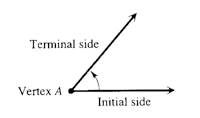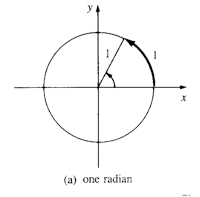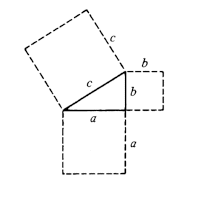The Pythagorean Theorem
Use the java applet to construct the proof of the Pythagorean Theorem. |

Pi is a Greek letter which represents a number approximately equal to
3.141592654. Pi is an irrational number and thus the number stated above is not
exact, but an approximation. To see the number represented by ![]() expanded to more decimal places, click here or here (two different versions).
expanded to more decimal places, click here or here (two different versions).
Archimedes, a great ancient mathematician, used a method called
"Exhaustion" ![]() to try to find a value for
to try to find a value for ![]() . It behoves us to know what that value
represents.
. It behoves us to know what that value
represents.
Quite simply put, ![]() represents the ratio between the circumference and the diameter
of a circle. Thus,
represents the ratio between the circumference and the diameter
of a circle. Thus, ![]() = c/d. The method of "Exhaustion" used by
Archimedes to find an approximation for
= c/d. The method of "Exhaustion" used by
Archimedes to find an approximation for ![]() can be viewed at a website which can be accessed by clicking here.
can be viewed at a website which can be accessed by clicking here.
We will also do one ourselves.....now ![]() .
.
Angles and Their Measurement
Definition of an angle.
 |
An angle consists of two half lines (rays) with a common initial point called a vertex. We agree that the terminal side is obtained by rotating the initial side counterclockwise through the angle t. An angle is in standard position with its vertex at the origin and its initial side along the positive x-axis. |
An angle of positive measure is obtained when the
terminal side is rotated counterclockwise and an angle of negative
measure is obtained when the angle is rotated clockwise. Angles obtained by
different rotations that have the same initial and terminal sides are called coterminal.
Measurement of an angle
There is a difference between an angle (a geometric object) and its measure (a number). However, it is correct to say that "an angle is x units" so that our work does not get too tedious.
Degree
The classical unit used to measure angles is a degree. A complete rotation so that the terminal side lies on the initial side is an angle of 360°, so 1° is 1 / 360 of one complete rotation. Parts of an angle are measured in minutes and seconds.
Hereafter the following symbols will be used:
° = degrees
' = minutes
" = seconds
Based on the definition of the degree (in the preceding paragraph), the following equivalencies should make sense:
| 1° = 60' | 1´ = 60" |
| So it follows that 1° = (60)(60)" = 3600" | |
| (1/60)° = 1' | (1/60)' = 1" |
| So, it follows that 1" = (1/60)(1/60)° = (1/3600)° | |
Now, using conversions based on the equivalencies noted in the
table above, we can change units from degrees, minutes and seconds to decimal
equivalencies:
| 42° 25´ 48´´ |
| = 42° + 25(1/60)° + 48(1/3600)° |
| = 42° + (25/60)° + (48/3600)° |
| = 42° + .4167° + .0133° |
| = 42.4300° |
Radians
A more convienient unit to measure angles in applications is a radian.
 |
Consider a circle with radius 1 unit. Start at the point ( 1,0 ) and measure 1 unit counterclockwise along the circumference of the circle. Mark this point and and join it to the origin to make the terminal side of an angle. This angle is 1 radian.
|
On a circle with radius 1 unit ( unit circle), an angle of 1 radian cuts off an arc of 1 unit on the circumference of the circle.
The circumference of any circle is 2![]() (radius).
(radius).
2![]() radians = 360° or
radians = 360° or ![]() radians = 180°
radians = 180°
The angle in radians is the ratio of the length of the arc on the
circle to the length of the initial side of the angle, so it has no dimensional units.
Changing units between degrees and radians. Using
the equivalency of ![]() radians = 180°
radians = 180°
we can write that as a ratio: ![]() radians are to 180° as x radians are to t °
radians are to 180° as x radians are to t °
Or mathematically speaking:
![]() radians
= x radians
radians
= x radians
180° t
°
Enter your given angle ( either degrees or radians ) into the proportion and solve for the
unknown.
| A. 30° = ? radians 180° 30° 180 x = 30 x = |
B. 180° t° 2t = 180° t = 90° |
